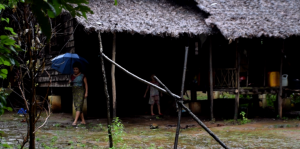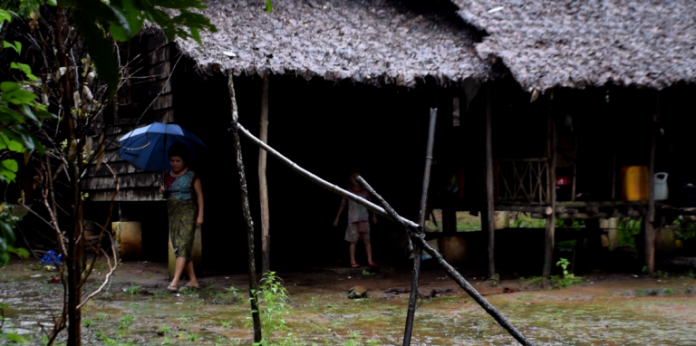A 40-year-old woman is rocking a cradle in front of a thatched roof hut, with bamboo flooring.
The little house belongs to Naw Sein Mu, an ethnic Karen woman who wears her hair short. Plastic buckets are scattered in front of the house. Her infant grand-kid is asleep in the cradle.
Naw Sein Mu had been living in the Thit Sa Aye Myine Democratic Karen Buddhist Army (DKBA) soldiers veteran housing area located in Myine Kyi Ngu in Karen State since 2011.
Due to intensifying armed conflicts, they moved to the Karen National Union (KNU) – controlled area in Shwe Pa Lar Kya village, Par Bon Township. It has been almost six years since her husband, a former DKBA soldier left for Bangkok, Thailand to work.
“We have been fleeing the conflict since we were young, and now we are longing for genuine peace. We would be delighted once peace is restored.” Naw Sein Mu spoke in Karen while gently rocking the cradle.
But her eyes look empty when she is asked about the peace process in Myanmar.

In 2011, the DKBA and the Karen State government jointly implemented Thit Sar Aye Myine military veteran housing project.
It is located in Hlaingbwe Township, a two-hour drive from Hpa-An. Families of deceased DKBA soldiers and soldiers who lost limbs during the war reside here.
The housing project has a population of 1500 living in just 278 houses. There are about 70 widows, 100 people with disabilities and more than 80 elderly, according to the President of the housing project.
The Union government provides one bag of rice along with 30,000 kyats to each household every month.
Naw Sein Mu considers herself a widow. She is a mother of three sons and three daughters. Two daughters are currently working in another city as housemaids and her eldest son is a migrant worker in Thailand.
Her remaining children plus a son-in-law, and grandchildren all live with her. The extended family, receives 100,000 kyats/month from her two daughters who are working as housemaids.
The civil war in Karen State started in 1949, which is considered to be one of the world’s longest civil wars in the world. Landmines in their hometowns and the longstanding civil war have made them internally displaced refugees.
People living in the mountain areas are afraid of both KNU and Myanmar military. “They are terrified and flee the area,” explained Naw Nan Dazin a conflict victim who now works as a nurse in the Myine Kyi Nyu special region. She adds, “The important thing is peace. Peace is what they want. When [we] achieve peace, we will become more independent and it does not matter how difficult our lives get, we can at least find livelihoods.”
The conflict has effectively cut the community off from the rest of the world for the last eight years. There are no ways to make a proper livelihood, and they have lost their civil rights and political freedom.
In November 2018, at the third round of Myanmar peace process, known as the 21st Century Panglong Conference, ten ethnic armed group leaders and ten leaders from the government met, in an effort to advance the peace negotiations. However, the KNU and the Restoration Council of Shan State (RCSS) temporarily suspended their participation from the official peace dialogue. As a result, the high- level Joint Implementation Coordination Meeting (JICM) and the Union Peace Dialogue Joint Committee (UPDJC) discussions were put on hold.
The peace process has not gone smoothly.
The Chin National Front (CNF) Vice-Chairman Dr. Lian H Sakhont said, “All the border areas on the Myanmar map [have] now become conflict areas. [These] areas have turned into the conflict zones, now people in the area look like they are living in a museum — a place where they could never leave.”
According to the United Nations (UN) [Women], it is largely women and children who have become the victims from conflict and wars occurring around the world. Yet women’s voices are rarely brought to the table for peace discussions, noted Dr. Lian H Sakhont.
He added, “In our country, there are people who are being left out of the peace process and their voices and cries are never heard. We need to listen to their voices. But what we always hear is the voices of men who are politically influential.”
The four fundamental social principles agreed to at the second round of 21st Century Panglong conference acknowledged that everyone including adults, persons with a disability, women, and children deserve the right to improve the quality of their lives regardless of nationality, religion, wealthy or poor. It has been two years since this agreement was made.
According to Nan Mya Thida, a spokesperson for the Research Institute for Society and Ecology (RISE) based in Karen State said, “If those [principles] from the Union agreement were not mentioned in the law enacted by the Hluttaw [Parliament], then how could it be reliable?”
Gender inequality and the peace process
Myanmar ranked 148th out of 198 countries on the 2018 Gender Inequality Index, this poor standing attests to one aspect of the country’s underdevelopment.
It also speaks to the need for greater women’s participation in the peace process said Daw Nan Phyu Phyu Lin, an advisor with the Alliance for Gender Inclusion in the Peace Process (AGIPP).
She notes that, “…men believe women are irrelevant to [politics] and [sometimes] women also perceive themselves that way. [Women] are overburdened with family responsibilities [and some] women do not really [support] each other. It is a relatively low number of role models of female in leadership,” Daw Nan Phyu Phyu Lin added.
Increasing women’s participation in peace negotiations has been shown to have very constructive outcomes. According to a study of 182 international peace agreements forged between the years 1989 and 2011, in cases where women’s participation in the peace process was present, an estimated 35 percent of those peace agreements lasted for over 15 years.
Women’s participation in Myanmar remains challenging.
Myanmar National Committee for Women (MNCW), comprised of representatives from the government and women’s organizations across the country, established a policy granting equal rights for women to participate in political, economic, and society and to receive the necessary information to engage effectively. The policy has been difficult to implement without any Union level budgetary allocation, said Daw Nan Phyu Phyu Lin.
According to some activists, women’s empowerment is also needed. “We cannot force [people] to have an interest without any motivation from the environment where they live. Also, I do not think the women’s involvement would be possible, if we are not able to raise awareness of the relevance of our work with them,” said Nan Mya Thida.
According to Mya Thida, there are strong Karen women in her village, but they face challenges in terms of language barriers, limited knowledge in technology and ability to get into a discussion when attending the peace negotiation at the Union level.
Mya Thida, argues that it is not enough to just ask women to take part in the peace process when there has been a cultural and political legacy neglecting women’s equal participation for 70 years. “How could women be brave or confident enough to discuss shoulder to shoulder with men if gender equality has never been present?”
Women’s participation in the 3 peace conference meetings started at 13%, moved to 17% and only reached 22% at the most recent conference. This marginal growth of women’s participation shows that progress has been slow. This is also well below the 30% benchmark recommended by the United Nations and the percentage agreed to by the parties to the national peace accord.
In Myanmar, thousands of innocent civilians see no way out of the long standing armed conflicts, And women like Naw Sein Mu are countless.
Due to the war, women have lost their sense of personal safety, security and welfare. These traumas are often passed on to a younger generation. Finding solutions is crucial for the country, as is the need to bring the voice of women who endure the consequences of conflict into the political discussion, say women activists.
“The participation of women in the peace process should increase up to 50%. Women are relevant to all facets of the discussion whether in society, politics, security, land or natural resources, ” added Nan Mya Thida.
She further notes that Myanmar’s peace process needs to consider the voices of those who have been neglected, or kept silent. “What is it like in a house without a woman? It is not ok. So nation building without women is not going to work. If it is a federal state that we all are going to build, women and men should work together in all sectors in order to sustain it in the long run.”
If women are excluded in the decision making process, who will protest for them?” asks Nan Mya Thida.
Naw Sein Mu, sits in her knee length longi, wrapped tightly, as the evening descends on her small home. She quietly rocks her grandson, both silent victims of prolonged armed conflict.
When asked what she would say if given the chance, her voice cuts through the dark, “My message to the leaders is, we want peace and want it to happen very soon. I believe that we have a chance to witness peace. At the same time, we feel worried that [we may] never achieve peace even after we are dead.”

